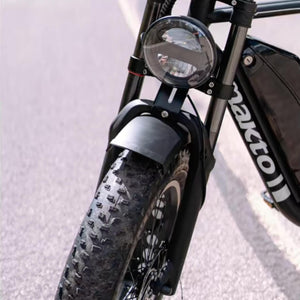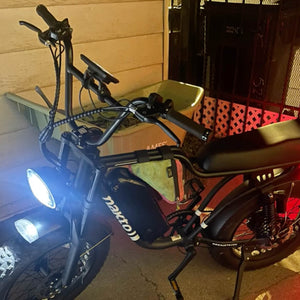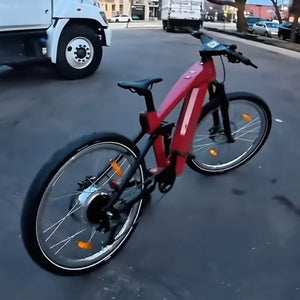Why Personal Electric Vehicles (PEVs) Are the Smart Alternative to Cars
Feb 19, 2025
Introduction
Owning a car is expensive. Between gas, insurance, maintenance, and unexpected repairs, car ownership drains thousands of dollars from your wallet every year. Not to mention, sitting in traffic is a waste of time, and parking in crowded areas can be a daily headache.
That’s why more people are turning to Personal Electric Vehicles (PEVs)—such as e-bikes and electric scooters—as a cost-effective, time-saving, and eco-friendly alternative to cars. Whether you're commuting to work, running errands, or just exploring your city, a PEV could be the best transportation investment you make.
So, how do PEVs stack up against cars? Let’s break it down.
Power Usage: PEVs Consume Far Less Energy
When comparing gas-powered cars vs. electric-powered PEVs, the difference in energy consumption is staggering.
Gasoline vs. Electricity
- A typical car burns around 500 gallons of gasoline per year.
- A moderate electric car uses around 3,500 kWh of electricity per year.
- A PEV (e-bike or scooter) uses about 300-700 watt-hours per charge, which totals about 100-250 kWh per year.
In dollar terms, an electric bike or scooter costs just $10-$30 per year to charge, while an electric car costs hundreds, and a gas-powered car can burn through $1,500+ in fuel annually.
Bottom Line: PEVs consume significantly less energy and cost pennies to operate, making them the most energy-efficient personal transportation choice.
Time Savings: Faster, More Efficient Commuting
Many people assume that cars are faster than PEVs. But in urban areas, e-bikes and scooters often get you to your destination faster than a car stuck in traffic.
Why PEVs Save Time
No Traffic Jams – E-bikes and scooters can cut through side streets, bike lanes, and park paths.
No Parking Hassles – Finding parking for a car can take 10-15 minutes in busy cities, while a PEV parks instantly.
Shorter Commutes – Many riders cut their commute times in half by using an e-bike instead of a car.
Real-World Example
- A 5-mile commute by car takes 20-30 minutes, including parking time.
- A 5-mile commute by e-bike takes 15-20 minutes, with no parking delay.
- A 5-mile commute by scooter takes 20-25 minutes, depending on speed limits.
Bottom Line: PEVs bypass traffic, eliminate parking stress, and reduce commute times, making them a practical choice for city dwellers and commuters.
Financial Savings: How Much Can You Save?
The real cost of owning a car is far higher than just gas. Let’s compare annual expenses:
Annual Cost Comparison: Car vs. PEV
| Expense | Car | PEV |
|---|---|---|
| Gas/Electricity | $1,500+ | ~$30 |
| Maintenance | $500+ | ~$100 |
| Insurance | $1,000+ | None or minimal |
| Registration/License | $100-200 | None |
| Parking Fees | $500+ | None |
| Depreciation | $2,000+ | ~$200 |
| TOTAL COST | $5,600+ | $130-300 |
Savings Potential: Switching from a car to a PEV can save you $5,000+ per year—enough for a vacation, investments, or other essentials.
Maintenance: Cars Require Constant Upkeep, PEVs Don’t
A car’s maintenance costs can be unpredictable and expensive.
Common Car Maintenance Costs
- Oil Changes – $50-$100 every 3-5 months
- Brake Replacement – $300-$800
- Tire Rotations & Replacements – $500-$1,000
- Transmission Repairs – $1,000+
Meanwhile, PEV maintenance is minimal:
- Tire replacements – $50-$150
- Brake pad replacements – $30-$100
- Battery replacements (after several years) – $200-$700
Bottom Line: PEVs require far less maintenance and fewer costly repairs compared to gas-powered cars.
Environmental Impact: A Cleaner Way to Travel
If you care about sustainability, PEVs are one of the cleanest transportation options.
- Cars emit an average of 4.6 metric tons of CO₂ per year.
- E-bikes & scooters produce close to zero emissions and run on clean electricity.
By switching from a car to a PEV, you can reduce your carbon footprint by over 95%!
When Cars Still Make Sense
While PEVs are an excellent alternative to cars, they aren’t for everyone. There are still situations where a car is necessary, including:
- Long-Distance Travel – If you commute over 30 miles per day, a car might be more practical.
- Transporting Multiple Passengers – PEVs are usually single-rider vehicles.
- Severe Weather Conditions – Snow, heavy rain, and extreme cold can make PEV riding difficult.
The Best of Both Worlds? Many people use a PEV for daily commutes and a car for long trips—saving thousands without fully giving up car ownership.
Final Thoughts: Should You Switch to a PEV?
If you want to save money, cut down on commute times, and reduce your environmental impact, a PEV is the way to go.
Key Takeaways:
- Power Savings – PEVs are up to 100x more energy-efficient than gas cars.
- Time Savings – No traffic, no parking stress, faster urban commutes.
- Cost Savings – You can save $5,000+ per year by switching to a PEV.
- Minimal Maintenance – No oil changes, no engine repairs—just simple upkeep.
- Eco-Friendly – Reduce your carbon footprint by 95% or more.
Ready to make the switch? If you already own an e-bike or scooter, keep it in top shape with regular maintenance and tune-ups.
Need a service check? Book an appointment today!







